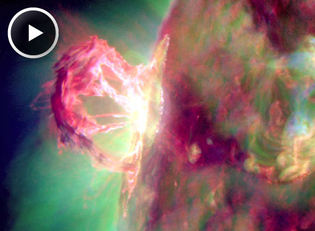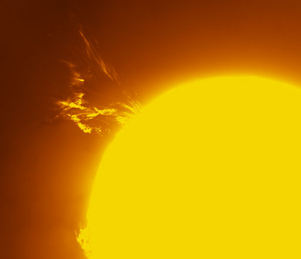| Magnetic fields on the sun's northeastern limb erupted around 17:45 UT on April 16th, producing one of the most visually-spectacular explosions in years. NASA's Solar Dynamics Observatory (SDO) recorded the blast at extreme ultraviolet wavelengths. The explosion, which registered M1.7 on the Richter Scale of solar flares, was not Earth-directed, but it did hurl a CME into space. Analysts at the Goddard Space Weather Lab have analyzed the trajectory of the cloud and found that it will hit NASA's STEREO-B spacecraft, the Spitzer space telescope, and the rover Curiosity en route to Mars. Planets Venus and Mars could also receive a glancing blow. |
| Using data from SDO, Steele Hill of NASA's Goddard Space Flight Center assembled a must-see movie of the event. It shows the explosion unfolding at 304Å, a wavelength which traces plasma with a temperature around 80,000 K. Coverage of the blast was not limited to space telescopes. Amateur astronomers saw it, too. Jim Lafferty sends this picture from his backyard observatory in Redlands, California. "Yesterday's prominence on the sun's eastern limb was was one of the largest in years---short lived, it was mostly gone in a few hours," says Lafferty. "It was a wonderful sight in the eyepiece and in the camera!" www.spaceweather.com |


 RSS Feed
RSS Feed